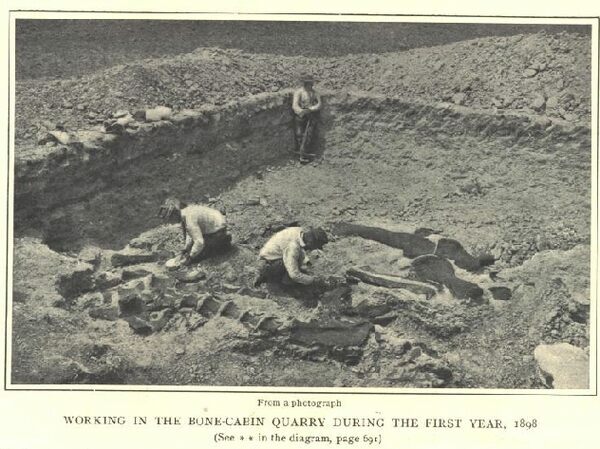This Specimen has been sold.
1.64" Fossil Camarasaurus Tooth - Bone Cabin Quarry, Wyoming
This is a beautifully preserved, 1.64" long tooth of Camarasaurus, a giant sauropod dinosaur from the Morrison Formation. It had very distinctive teeth that were designed for eating coarse vegetation. The tooth is free of feeding wear and has excellent enamel preservation.
This tooth was collected from the famous Bone Cabin Quarry in Wyoming. Comes with a riker mount display case.
There is a repaired crack through the tooth, with some gap fill near the edge of the tooth along this crack. A .3 x .2" wide patch of gap fill restoration can also be found near the basal end.
This tooth was collected from the famous Bone Cabin Quarry in Wyoming. Comes with a riker mount display case.
There is a repaired crack through the tooth, with some gap fill near the edge of the tooth along this crack. A .3 x .2" wide patch of gap fill restoration can also be found near the basal end.
About Camarasaurus
Camarasaurus was a medium-sized sauropod dinosaur whose fossils are found in the Morrison Formation of the Southest United States. It is estimated to have reached lengths of up to 75 feet long and had an estimated maximum weight of around 50 tons. Compared to contemporary Diplodocids, it had a shorter tail, longer forelimbs, and a much larger and more robust skull.
Camarasaurus skulls are quite distinctive: they have blunt snout and quite a square shape. Camarasaurus had large, spoon-shaped teeth, unlike many sauropod dinosaurs that had small, peg-like teeth. This likely indicates that it ate coarser vegetation, allowing it to share the same environment as other sauropods without competing for food. It may have replaced its teeth approximately every 60 days as they became worn from chewing. Its cervical vertebrae had hollow chambers to reduce weight on the neck, leading to its name, which means “chambered lizard”.
Camarasaurus is considered the most abundant of the sauropod dinosaurs found in North America. Its fossils have been found in almost every major Morrison Formation dinosaur locality, with fossils found in localities from across many states including New Mexico, Utah, Colorado, Montana and Oklahoma.
Camarasaurus was a medium-sized sauropod dinosaur whose fossils are found in the Morrison Formation of the Southest United States. It is estimated to have reached lengths of up to 75 feet long and had an estimated maximum weight of around 50 tons. Compared to contemporary Diplodocids, it had a shorter tail, longer forelimbs, and a much larger and more robust skull.
Camarasaurus skulls are quite distinctive: they have blunt snout and quite a square shape. Camarasaurus had large, spoon-shaped teeth, unlike many sauropod dinosaurs that had small, peg-like teeth. This likely indicates that it ate coarser vegetation, allowing it to share the same environment as other sauropods without competing for food. It may have replaced its teeth approximately every 60 days as they became worn from chewing. Its cervical vertebrae had hollow chambers to reduce weight on the neck, leading to its name, which means “chambered lizard”.
Camarasaurus is considered the most abundant of the sauropod dinosaurs found in North America. Its fossils have been found in almost every major Morrison Formation dinosaur locality, with fossils found in localities from across many states including New Mexico, Utah, Colorado, Montana and Oklahoma.
The Bone Cabin Quarry has historical significance because it was discovered in 1897 and excavated by the American Museum of Natural History from 1898 through 1905. It lies near the famous Como Bluff and got its name from a nearby sheepherder's cabin built entirely out of fossil dinosaur bones. This quarry now lies on private land, where it continues to be excavated.
SPECIES
Camarasaurus sp.
LOCATION
Bone Cabin Quarry, Wyoming
FORMATION
Morrison Formation
SIZE
1.64" Long
CATEGORY
SUB CATEGORY
ITEM
#306659
We guarantee the authenticity of all of our specimens.
 Reviews
Reviews














